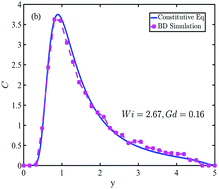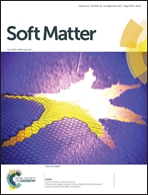Stress-gradient-induced polymer migration in Taylor–Couette flow
Abstract
We apply our recent continuum theory for stress-gradient-induced migration of polymers in solution (G. Zhu et al., J. Rheol., 2016, 60, 327–343) to rotational shearing flow in the gap between concentric cylinders (the so-called Taylor–Couette flow), where we have also accounted for the effect of polymer depletion from the solid boundaries on migration patterns. The steady-state distribution of dilute solutions of polymer dumbbells, obtained both using a systematic perturbation analysis in terms of the Weissenberg number (Wi) and by solving numerically the transport problem coupled to the upper-convected Maxwell equation, shows accumulation of polymers near the inner cylinder. This accumulation becomes so strong that most polymers are driven near the inner cylinder once Wi > 4. We also show that there is no first-order contribution to the polymer migration in Taylor–Couette flow due to the absence of a velocity component in the r-direction. Brownian dynamics (BD) simulations for a Hookean dumbbell give a concentration distribution in good agreement with the theoretical predictions of our theory, confirming the accuracy of the theory when the dumbbell radius of gyration is around an order of magnitude or much smaller than the gap. The demonstration of the accuracy of our continuum theory by direct molecular simulation opens the door to application of the theory to journal bearing and other lubrication flows containing polymers that may migrate due to stress gradients.



 Please wait while we load your content...
Please wait while we load your content...